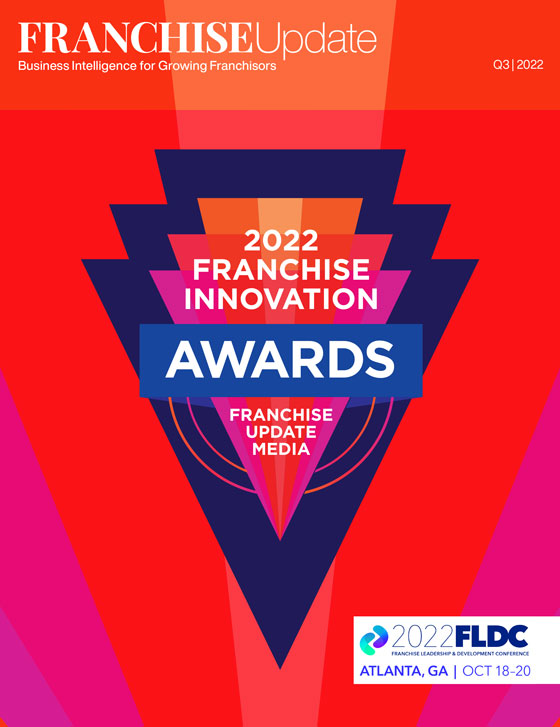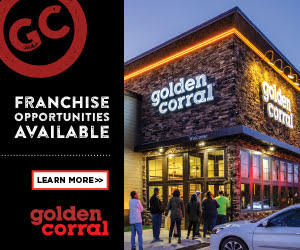Flying High: Wearing two hats as president and CMO

Amy Phillips holds a unique position at Altitude Trampoline Park: She is the brand’s president and CMO.
Phillips joined the brand in October 2020 as EVP in charge of brand experience. The next June she was named CMO, responsible for strategic marketing, brand messaging, and franchise development marketing for the 82-park brand with locations around the globe. This past February, she added president to her title and is now co-leading the brand’s franchise development efforts with CEO Mike Rotondo.
Phillips has been busy in her new role helping to expand the company’s leadership and corporate support team as the brand embraces growth and launches enhanced digital and in-park experiences, new guest offerings, and best-in-class guest services training.
“The goal is to push the boundaries of our guest experience and to evolve with our growing corporate team to support our franchise network in new and profound ways,” she says.
Phillips is quite familiar with the family entertainment business. Before joining Altitude, she spent nearly two decades working with brands including Pepsi, Dave & Buster’s, Main Event Entertainment, and Drive Shack. Since joining Altitude in 2020, she has led major brand-wide initiatives such as the successful membership program, which has driven double-digit sales increases at several of the brand’s locations.
What’s the most challenging part of being a CMO today? Our industry changes every single day, and the media landscape is more complex than it’s ever been. It’s important to make sure that you are working with your team to navigate the nuances of new media such as YouTube shorts and the changing algorithms around platforms like TikTok and Instagram—especially in the family entertainment industry, where what is working for us on these platforms this week may not work for us the next. If your company works with an outside agency partner, make sure that team also has their finger on the pulse of these trends.
How has Covid-19 affected the way you have led your brand’s marketing efforts? To keep customers confident in the safety of our parks, we implemented the C3 program (Caring through Cleanliness and Certification). C3 is a full-park protocol that includes extensive, CDC-approved cleaning procedures before, during, and after operational hours. Our membership program also reached its full potential post-pandemic, when families really began looking for a more cost-effective option for family entertainment. It’s a great value for families, and our guests have been quick to recognize the flexibility it provides them through the unlimited use of the parks’ trampolines and attractions any day and any time. Within our target demographic of parents with children ages 3 to 12, Altitude actually experienced an uptick in our business. Cooped up inside the house for so long, parents were willing to take the risk and bring their children to our parks. Many of the larger theme parks and restaurants haven’t seen that impact for their franchisees just yet.
What are the 3 most important keys to being an effective CMO leader today? One aspect is definitely the complexity of today’s media landscape. It’s so important to surround yourself with team members and agency partners who are constantly seeking out new platforms and evaluating the performance of our current tactics.
Another important aspect is the ability to understand your target audience. This process begins when, as a brand, we look at past experiences and perceptions to align on the psychographics and demographics that make up our core audience. Our guests are often children ages 3 to 12, but our target audience is really their mothers. We know that, more often than not, it’s mothers who make the decision to bring their children to our parks. We take that information and use it to guide our plans around what messaging will resonate with that audience, what channels we target with that messaging, and more.
To bounce (no pun intended) off that point, companies must know their value proposition inside and out. A value proposition isn’t necessarily based solely on price—there are a whole host of other factors, including environment, services, culture, and more, that make up a brand’s value proposition. When I think of great value propositions, I immediately think of Nordstrom’s return policy, where you can virtually return anything aside from some slight stipulations. Our CEO Mike Rotondo does a great job of articulating our value proposition, which centers around our membership program and providing that outlet for active family fun in the communities our parks serve.
How do you prepare a marketing plan and execute the strategies? Quite honestly, in the most traditional way possible. I’m a big fan of calendarizing our tactics and campaigns based on seasonality. In my experience, that doesn’t mean that plans won’t need to change based on current events or benchmark numbers. However, it allows our team to start with a plan and go from there. It’s okay to make modifications along the way, and essential to be flexible and reevaluate when something isn’t working. Many leaders can get so passionate about their plans, but we always need to make sure it’s working for our brand, franchise system, and, most importantly, our guests.
After we’ve created our plan, we bring it to the overall support center for feedback. As marketers, it can be easy to get stuck in our own heads. I’ve often found that some of the best ideas come from our support team’s fresh perspectives and from our franchisees. That’s why our marketing team reaches out to the high-performing franchise members in the system to discuss what’s working and what’s not three months before we start calendarizing. One of the great things about building those connections with the franchise owners is that when we implement one of their ideas, they become ambassadors and help work with others in the system to show its value. It doesn’t have to just be about marketing programs either, it can be POS updates or other system changes. We work closely with our franchisees to leverage their experiences for the good of the entire system.
How do you measure marketing results and effectiveness? It all boils down to whether or not your tactics and strategies are moving the needle in a positive direction for the franchisees at the local level. Of course we can set goals for the number of impressions our campaigns generate or the number of clicks a given ad set has, but the true measure of success comes from positive feedback from our franchisees.
One of our franchise owners had a background in the fitness industry before signing his agreement with Altitude, and he brought the idea of membership to our team during one of our planning discussions. Since we’ve developed the Endless Jumps membership offer, he’s signed well over 16,000 members at his park. That’s one great example of how I would measure the success of our membership program.
Discuss your core consumer marketing strategies and objectives. In addition to national activations such as our partnership with the American Heart Association, we layer in a healthy amount of local activities for our franchise locations as well. Through the relationships that franchise owners develop with their friends and neighbors, our parks become part of the communities they serve. Being actively involved in the areas your business serves can make a difference in your success.
In my experience, it’s so important to never get too far away from providing your franchise system with strong local marketing tools and guidance. There are times when we lose sight of the impact that partnering with local schools, charities, chambers of commerce, and other organizations can have on a franchise owner’s bottom line. It’s especially vital in the family entertainment industry, where our parks aren’t able to find real estate in high-traffic areas of suburban or urban communities.
How is today’s consumer and marketing data helping you fine-tune your marketing initiatives? It all goes back to making sure that you align on the demographics and psychographics of your target audience before building out a plan for a specific brand or market. In this day and age, there are hundreds of ways to find out who is engaging with your product or your service. As I said, we then take that information and use it to guide our plans around what messaging will resonate the most with that audience, as well as what media channels will be most effective in reaching them. By using consumer data when creating our marketing initiatives, we can more effectively reach the families most likely to bring their children to an Altitude Trampoline Park.
Describe your marketing team and the role each plays. We have a small but mighty marketing team here. Outside of our agency partners, our team consists of various roles, ranging from director of membership and event sales marketing to director of brand marketing. our director of membership and event sales marketing focuses on how to optimize and equip our parks with the collateral and sales channels that drive membership and event sales. In some cases, these sales can represent around 30% of our parks’ business. We’ve worked hard to build out our call center so that there’s one point of contact for our guests to call and book any of our 82 parks. Our director of brand marketing works with our agencies and franchisees to ensure that all our PR, creative, and messaging aligns with our brand. She does a wonderful job of overseeing a whole host of agencies tackling digital media, nontraditional marketing, and more.
Why is it so important for the marketing department to have a “personal touch?” How does this help your franchise sales and development effort? Many franchisees sign on with a brand because they already believe in the brand’s mission, vision, and general brand awareness in their markets. This goes even a step further with our franchisees, because most of our owners were guests in our park first. In our work with potential franchise candidates, it’s important for us to help them pictures themselves and/or their families in the park. I can think of a handful of franchise owners in the system who invested in our concept to bring a clean, safe space for indoor play to not only the children in their community, but for their own children as well.
Franchise owners also recognize they are investing in a brand with a marketing department that works to generate exposure for the brand as a whole at a national level as well as support them at the local level. Prospective franchisees want to see that they can rely on the corporate team to provide them with the standards, insights, and tools to help them effectively market to their guests. We aim to show them that they don’t have to reinvent the wheel to be successful.
Do today’s prospects expect more from the franchise marketing department? What, and how do you provide it? I would say yes, they do. As I mentioned, the media landscape is incredibly complex and changing every day. Franchisees rely on us to know the ins and outs of new strategies and platforms, because there are so many more than there used to be. It can become very overwhelming for them to manage on their own. They rely on us to make those hard decision for them when it comes to what channels they should be using to reach consumers and the value of one medium over another.
How do you work with other internal departments, and does technology help? While our leadership team and franchise system are spread out across the world, for me, nothing really replaces human interaction. It can get difficult to do everything remotely without meeting with our franchisees and making that connection, that bond, beyond the screen. That being said, we work very closely with our operations department. Nick Doll, our vice president of operations, and his team are very hands-on, and have been out visiting our franchisees in their parks. They become the voice of the marketing department, bringing franchisees up to speed and on board with the rollout of new promotions, processes, systems, and other initiatives.
When it comes to the intersection of marketing and technology, we work very closely with Joseph Steen, our director of IT. We recently partnered with Yiftee, an operating system that works to standardize the sale and use of gift cards for our guests. Technologies like Yiftee can function a lot like marketing with a franchise system like ours. The franchise owners are looking for a system that is easy for their young adult employees, many of whom were guests in our parks at one point, to use.
Do you see vendors as business partners? Why/why not? Definitely. Our vendors are an extension of our team. More importantly, we rely on them or their products to operate at the same level of excellence and expertise as our team does. We’re always looking for vendors who can move the needle in a way that benefits the entire franchise system. Before an organization can become one of our nationwide vendors, they go through an application process with our leadership team to make sure they meet the criteria and standards we have set in place. Then we test and vet them through our franchisees before we move forward and make them an official vendor. Even our agency partners go through a strenuous RFP process before we bring them on board.
Many of our current vendors have come from our franchisees. They started off working with them on a local scale and then recommended them to our leadership team. Additionally, members of our leadership team might bring vendors they’ve worked with at past concepts to our attention. Our VP of operations and VP of development built several relationships over their time in the restaurant and family entertainment sectors, respectively, and that personal experience can go a long way in building trust with our entire system.
What advice would you offer to aspiring CMO executives? I’m a big fan of networking. Personally, I love the American Marketing Association, but there are so many other organizations you can get involved in. I’d also recommend going to conferences and sharing your accomplishments with your network on LinkedIn. I’ve participated in the Women’s Foodservice Forum in the past and met amazing female professionals in the hospitality industry, created different relationships with them, and learned a lot about what and how a CMO leads.
To a degree, it’s also results. If you can find a way to get the results and make a difference for the bottom line, you can be anything and everything that you want to be. Remember to ace the “humble brag” and to go after those awards and recognitions that you wouldn’t normally go after. I’m fortunate to have great agencies and partners who can tell that story for me, but you don’t have to be a CMO to craft those stories for yourself.
Share this Feature
Recommended Reading:
FRANCHISE TOPICS
- Multi-Unit Franchising
- Get Started in Franchising
- Franchise Growth
- Franchise Operations
- Open New Units
- Franchise Leadership
- Franchise Marketing
- Technology
- Franchise Law
- Franchise Awards
- Franchise Rankings
- Franchise Trends
- Franchise Development
- Featured Franchise Stories
FEATURED IN

Franchise Update Magazine: Issue 3, 2022








 The franchise listed above are not related to or endorsed by Franchise Update or Franchise Update Media Group. We are not engaged in, supporting, or endorsing any specific franchise, business opportunity, company or individual. No statement in this site is to be construed as a recommendation. We encourage prospective franchise buyers to perform extensive due diligence when considering a franchise opportunity.
The franchise listed above are not related to or endorsed by Franchise Update or Franchise Update Media Group. We are not engaged in, supporting, or endorsing any specific franchise, business opportunity, company or individual. No statement in this site is to be construed as a recommendation. We encourage prospective franchise buyers to perform extensive due diligence when considering a franchise opportunity.